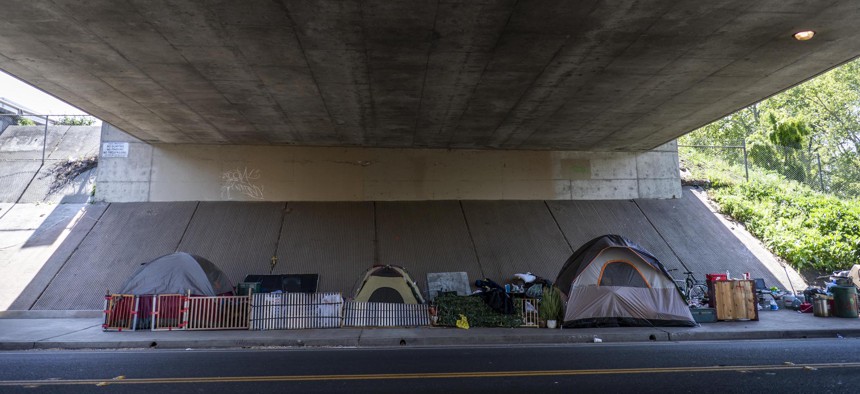California Governor Announces Plan to ‘Create More Housing, Faster’

A homeless encampment of tents neatly sit underneath the I-5 freeway in Sacramento, California Sunday April 3, 2022. Melina Mara/The Washington Post via Getty Images
In an effort to tackle one of the country’s largest homeless populations, Gov. Gavin Newsom last week announced plans to build 1,200 tiny homes and spend $1 billion on local homelessness initiatives.
As California continues to grapple with the country’s highest rates of homelessness, Gov. Gavin Newsom announced 1,200 small homes will be delivered and built in some of the state’s largest cities and $1 billion will be available to further local and regional homelessness initiatives.
In what is being described as the state’s largest mobilization of small homes, Newsom said the California National Guard will help deliver a fleet of small homes to four communities: Los Angeles (500 units), Sacramento (350 units), San Jose (200 units) and San Diego County (150 units).
“In California, we are using every tool in our toolbox—including the largest-ever deployment of small homes in the state—to move people off the streets and into housing,” he said. “We are tackling this issue at the root of the problem by addressing the need to create more housing, faster in California.”
Some leaders see non-congregate shelters—a living space that offers some level of privacy— as a cost-effective way to quickly house people experiencing homelessness. Cities around the country are partnering with local nonprofits and vendors to set up “villages.”
The effort in California will build off existing efforts and will cost about $30 million. The state is aiming to deploy the shelters over the next several months. Once the homes are set up in the four communities, the local jurisdictions will be responsible for maintaining them and providing services to residents.
The cities and county were selected because of local leadership’s enthusiasm and demonstrated success in working to reduce homelessness, Newsom said. He added that people living in encampments should be prioritized when it comes to finding tenants for the tiny homes.
In San Jose, tiny-home communities are already making a difference, according to Mayor Matt Mahan. Since 2020, the city has built four tiny home villages, reducing the unsheltered population by 9%, Mahan said at Thursday’s press conference.
“We all agree that building more housing, especially more affordable housing, is the long-term solution,” he said.
But some argue the initiative will barely make a dent in sheltering the state’s roughly 174,000 residents experiencing homelessness.
“While I appreciate the governor’s creativity to construct 1,200 tiny homes, that is a drop in the bucket,” said State Senate Minority Leader Brian Jones in a statement, describing the initiative as “just another band-aid on a crisis.”
In addition to the shelters, Newsom also announced $1 billion in funding as part of the fourth round of grants under the state’s Homeless Housing, Assistance and Prevention (HHAP) initiative. HHAP, which Newsom launched in 2019, has allocated nearly $2 billion to support local and regional efforts in addressing homelessness. Eligible uses for the funding include rental subsidies, street outreach and motel conversions.
Newsom clashed with local officials and service providers last year when he withheld nearly $1 billion in homelessness funding, saying the plans weren’t ambitious enough. Local officials had collectively committed to reducing homelessness by 2% by 2024 as the original goal. They have since revised their plans, now targeting a 15% reduction by 2025.
For more than a decade, California has had more homeless people than any other state, according to the Public Policy Institute of California. Last year, nearly a third of the country’s total homeless population resided in the Golden State.
But Chione Lucina Muñoz Flegal, executive director of the housing advocacy group Housing California, thinks the state may be moving in the right direction when it comes to addressing the homelessness crisis.
“California is making important progress and could be poised to turn the corner on the homelessness crisis, thanks to leadership from communities, the legislature and the governor,” Flegal said in anl statement to Route Fifty.
She added that HHAP funding has reduced youth homelessness by 21%, and mutual accountability of state and local leaders is critical in addressing the crisis.
Despite HHAP’s success in some areas, California’s homeless population grew by 22,000 during the pandemic.
And in many ways, the program is still evolving. In the first rounds, there were few strings attached to the funding, and critics argued it was difficult to determine how effectively the money was being spent, The Sacramento Bee reported. There are now more stringent requirements for funding, but advocates are calling for more reliable, ongoing funding.
Molly Bolan is the assistant editor for Route FIfty.
NEXT STORY: Governors Push Faster Construction to Meet Housing Needs






